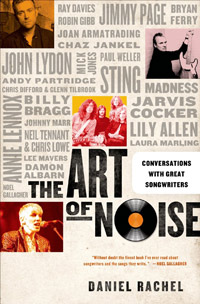Books: The Art of Noise: Conversations with Great Songwriters
Author Daniel Rachel’s Oral History of British Songwriting
The Art of Noise was a 2013 Guardian and New Musical Express Best Music Book of the Year, but it wasn’t published in America until October 2014. However, that’s not as surprising as it might seem when you look at the table of contents and realize every single songwriter is British.
Author/interviewer Daniel Rachel is clearly drawn to Britpop of the 1990s and to a certain type of thoughtful pop-rock that preceded and followed it. Among those he talks with are Damon Albarn of Blur, Jarvis Cocker of Pulp, Noel Gallagher of Oasis, Neil Tennant and Chris Lowe of Pet Shop Boys, Chris Difford and Glenn Tilbrook of Squeeze, Andy Partridge of XTC, Bryan Ferry, and Billy Bragg.

Essentially, The Art of Noise is a British version of Paul Zollo’s classic Songwriters on Songwriting, which included interviews with Bob Dylan, Neil Young, Brian Wilson, Leonard Cohen, David Byrne, and others. As the names listed indicate, discussions of male songwriters tend to predominate in books written by male authors, an issue Rachel confronts directly by asking his mostly male interviewees why they think there are so few female songwriters. “Sexism,” they tend to answer, although a few, like Cocker, seem genuinely baffled: “I wouldn’t know that at all. I don’t think there’s any reason why that should be.” Of course the situation isn’t as dire as Rachel suggests — even in Britain. The names of interesting female songwriters he might have interviewed come quickly to mind: PJ Harvey, Kate Bush, or KT Tunstall.
Each interview is preceded by a detailed and thoughtful essay on the songwriter’s work. Rachel is obviously a fan of the people he interviews, which means his questions can be very detailed. He asks Johnny Marr of The Smiths if “the tremolo and slide figure [were] part of the original demo” of “How Soon is Now.” He wants to know if Robin Gibb of the Bee Gees is playing the Leslie organ on “With the Sun in My Eyes.” Indeed, if the book suffers from a persistent weakness, it’s the lack of editing. Rachel documents every single thought uttered by his heroes, no matter how pedestrian it is.
Some of Rachel’s more esoteric questions seem to spring from the fact that he is a musician himself: He’s not afraid to ask about tricky time signatures and flatted fifths. Fortunately, the songwriters are wary of sounding pompous, and even fairly sophisticated composers like Sting and Damon Albarn reply in straightforward terms. Not surprisingly, though, the more accomplished the musician, the clearer the explanation of the composing process. Songwriters with little or no formal training, like Noel Gallagher and Mick Jones of The Clash, are far less articulate in an interview than they are in their music. Jones says of songwriting, “it comes from nowhere. It’s out there. It’s in there, but when you do one bit of music the next bit is in the bit that you did. It’s already there.”
If this sounds confusing, Jones is hardly alone in making the art of songwriting sound like a pretty haphazard affair. Some songwriters go to work every day at the piano or guitar or computer; others don’t. In general, though, ideas arrive at random, with the songwriters scribbling down lyrics or recording riffs before they forget them. Only gradually do they stitch their raw materials into a finished product. It’s the rare song that arrives fully formed.
Overall, however, there’s not a great deal of useful specific advice for aspiring songwriters in The Art of Noise. What readers will find is a chatty history of post-’60s rock and roll in Britain. As Thom Yorke (who is not interviewed in this book) of Radiohead sarcastically remarked, “Anyone can play guitar.” Evidently, given the right amount of luck and persistence, just about anyone can also write a song.



